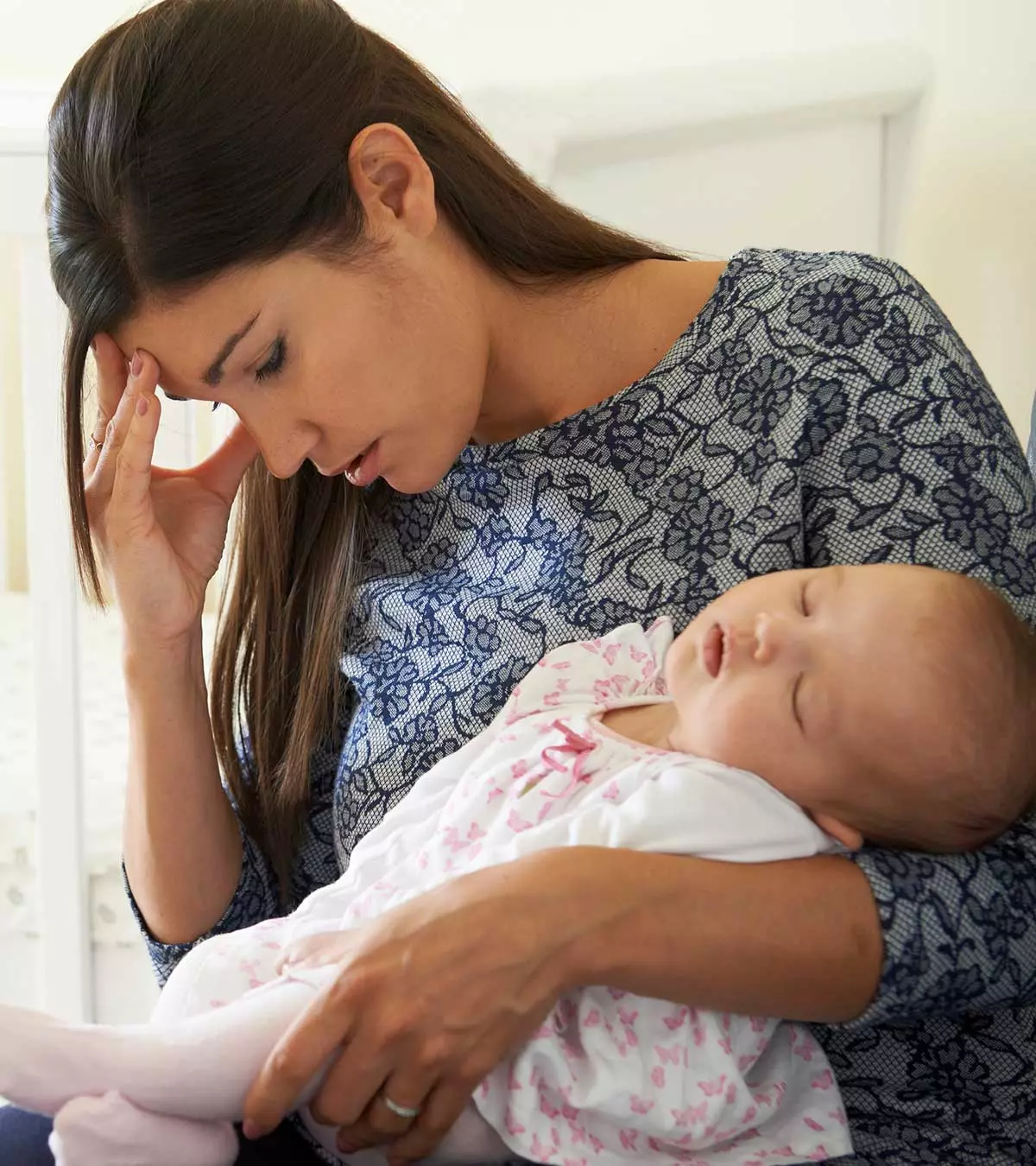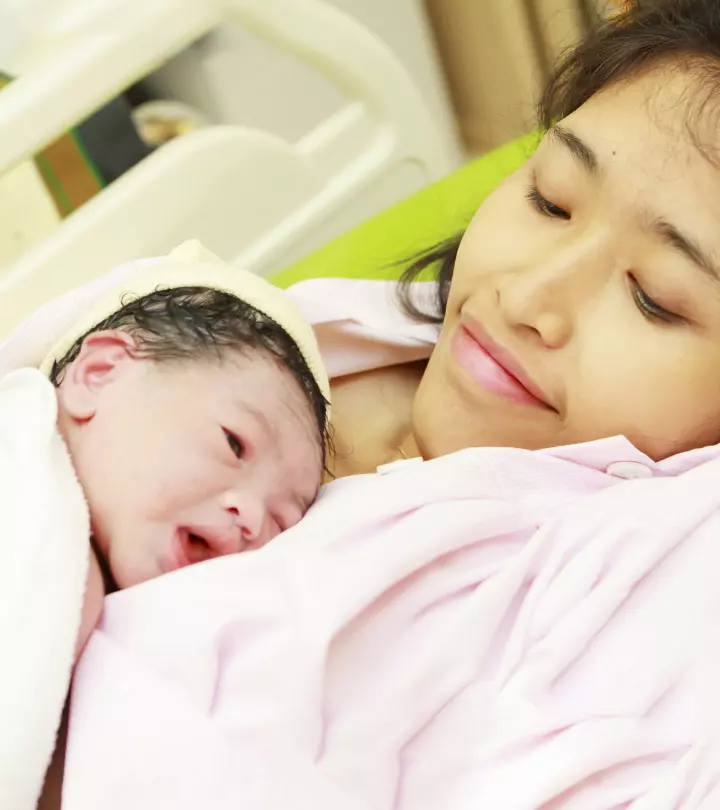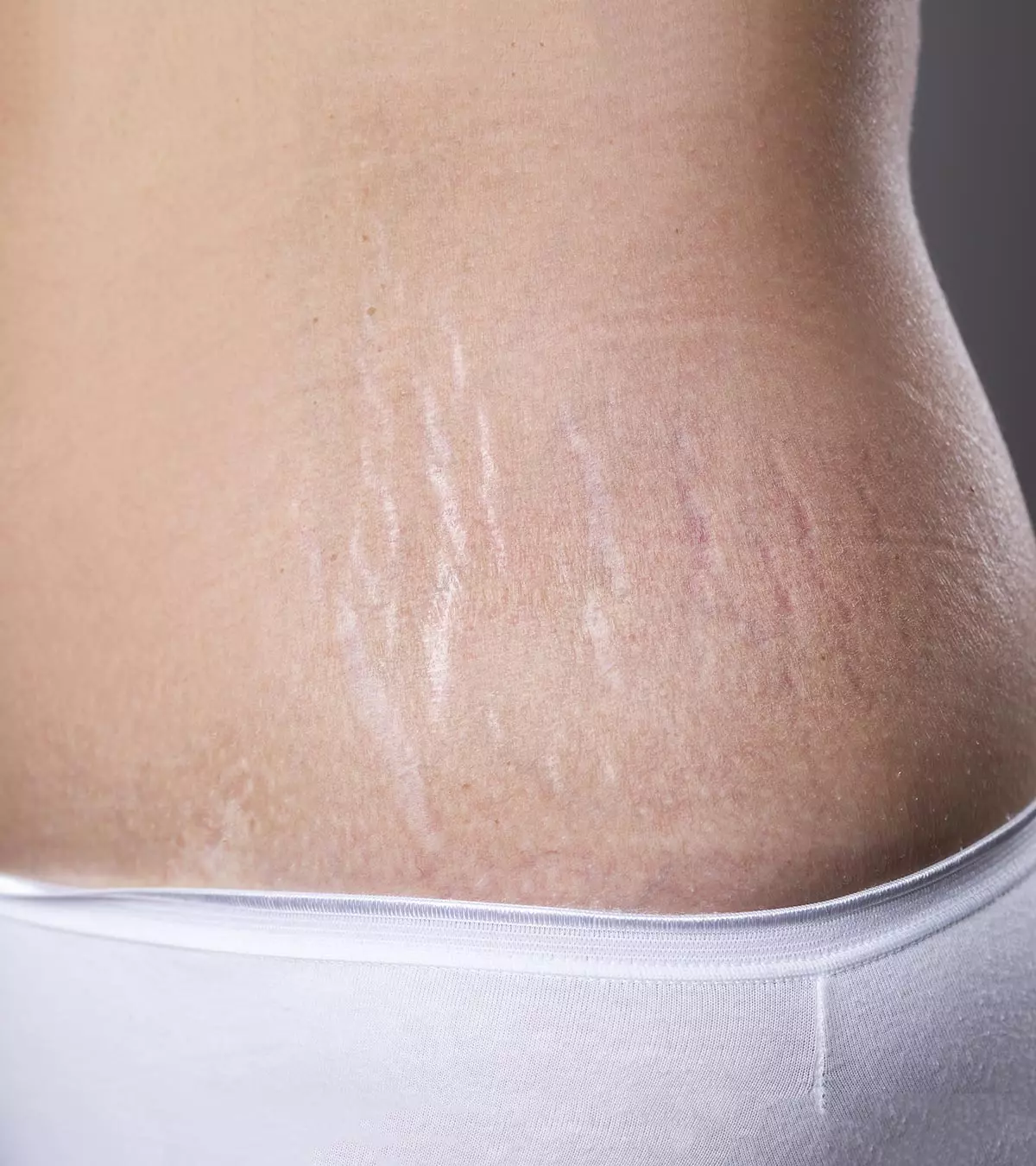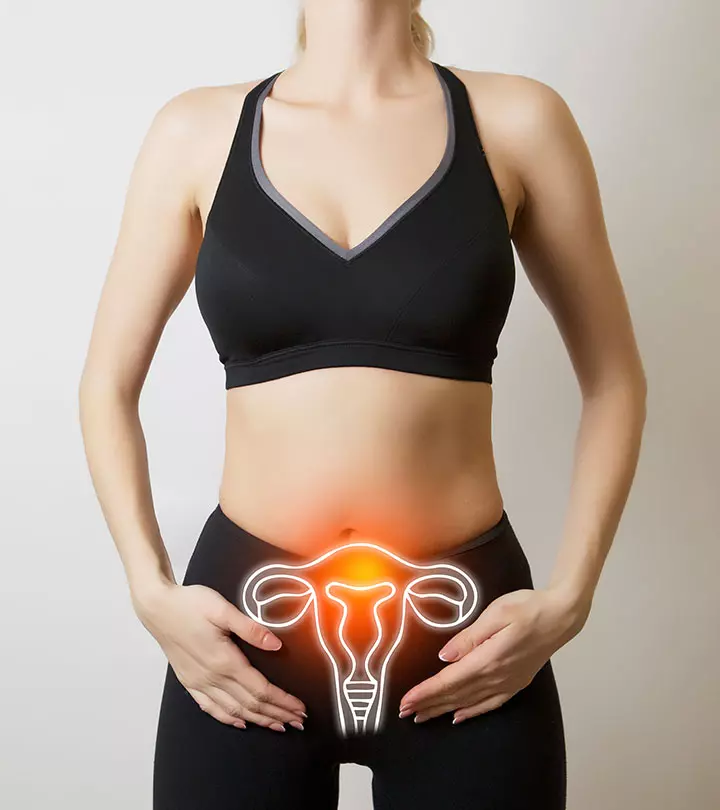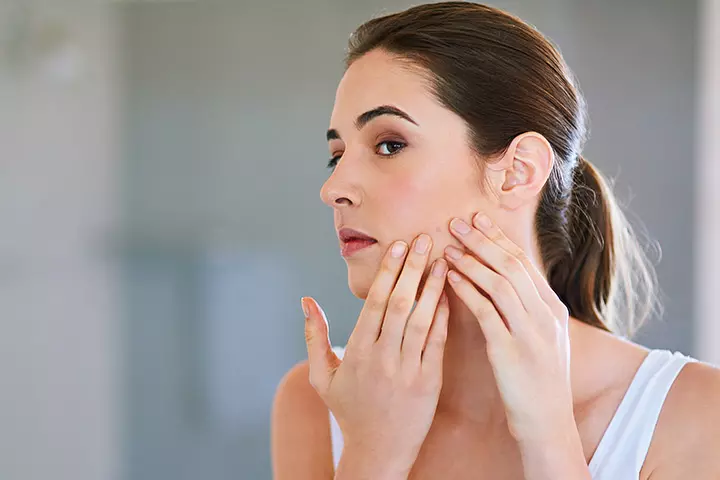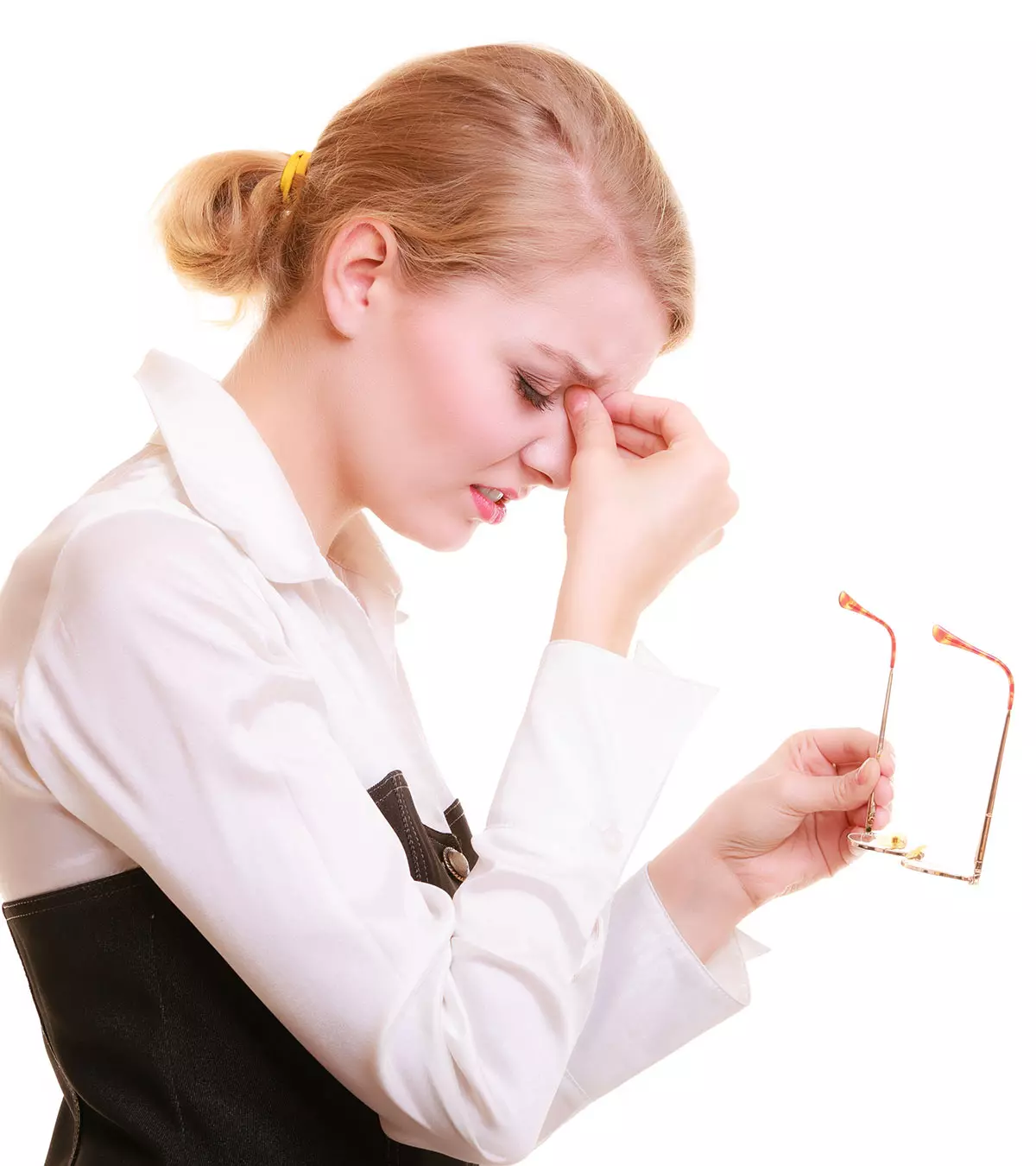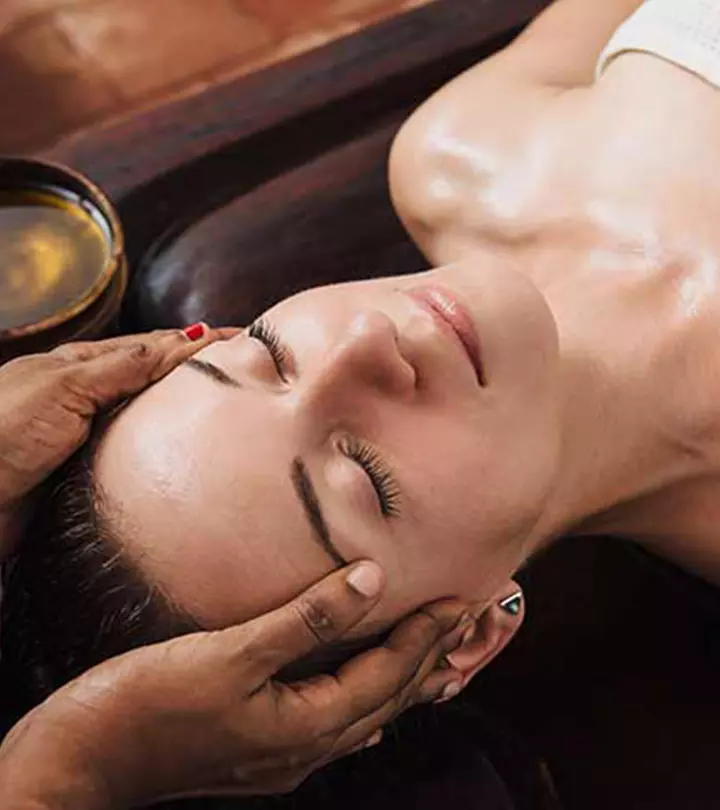
Image: ShutterStock
The delivery process is challenging and can mentally and physically drain you. So, while you care for your baby, care for yourself as well with a relaxing postpartum massage. A postpartum massage is a full body massage that mothers get a few weeks after childbirth. The massage helps the mother’s body and mind relax and hastens postpartum healing. If you are an expecting mother, knowing about the benefits of postpartum massages can help you make informed choices. Read this post to learn about the right techniques for a postpartum massage, the oils most suitable for it, and when you should avoid it.

Key Pointers
- Postpartum massage relaxes the mind and the body and reduces pain and soreness.
- Opting for a postpartum massage under expert guidance once fully recovered is vital for a safe massage experience.
- Following all necessary precautions, selecting the best massage oil and the right massage technique helps reap massage’s full benefits.
What Is Postpartum Massage?
A postpartum massage is a complete body massage given to the new mom to soothe and relax her mind and body, and also alleviate any pain or soreness in the body. A good massage can support the physical, emotional, and mental well-being of the mother (1).
Following childbirth, you can take an appointment with a masseuse or massage therapist who specializes in postpartum massages.
 Did you know?
Did you know?When Can You Get A Postpartum Massage After Delivery?
You may opt for a postpartum massage when you feel you are comfortable. Whether you’ve had a cesarean section or vaginal delivery, you will need around six to eight weeks for complete recovery (2). Ideally, it is best to wait until you are fully recovered after the delivery and then get a massage. However, it is good to consult your healthcare provider before you schedule one.
Discuss your specific postpartum experiences and any complications with your healthcare provider, as they can recommend tailored approaches and suitable massage techniques to ensure safety and effectiveness.
Furthermore, understanding your body’s signals is essential. If you experience any unusual symptoms during or after the massage, such as increased pain or discomfort, seek immediate guidance from your healthcare provider.
Benefits Of Massage After Delivery
Listed below are some benefits that massage therapy offers after you give birth (3).
- Relieves pain: Body pains, particularly in the lower back, hips, and abdomen, are normal during pregnancy. Massage can help relax these sore muscles and ease the pain. An experienced therapist can also help alleviate numbness and tingling. If the pain is persistent or intense, multiple treatment sessions may be necessary for relief (4).
- Reduces swelling: The blood volume increases by around 50% during pregnancy, and body fluids are to be balanced after pregnancy (5). Postpartum massage helps improve circulation and stimulate lymphatic drainageiDrainage of excess lymphatic fluid from tissues, which can be done through a manual massage technique to eliminate fluids and toxins from the body.
- Helps you sleep better: Massage therapy eases the fatigue, provides relaxation, and makes you sleep better.
- Opens blocked ducts: A session of gentle lactation massage could remove the hardened lumps and open the blocked ducts in the breast, thereby lowering the risk of mastitisi Infection in the breast tissues usually caused by bacteria or blocked milk ducts leading to pain and inflammation while breastfeeding . On the other hand, a vigorous massage can worsen mastitis.
- Improves post-delivery recovery: Commonly experienced postpartum blues such as depression and anxiety are related to hormonal changes. Massage could help treat depression and other baby blues, and it improves mood too (6).
 Quick fact
Quick factThe massage techniques used and the position you rest in during the massage can improve the outcome of the massage.
Tina Yong, a mother, shares her experience of getting a postpartum massage on her YouTube channel. She says, “The therapist would come over for a 90-minute session, and she’d massage my whole body and try to get my circulation flowing. She would also do a Javanese massage technique where she would bind my belly using a long strip of cloth. It was done not to slim me down but to help retract the uterus and help organs go back in place as well. It helped with my posture because while breastfeeding and after giving birth, my balance was off, so having that binding helped support my back and helped me sit up straighter. I had ten sessions of that, and I felt like that helped get my belly all that bulge to go down faster (ⅰ).”
Best Positions For A Post-pregnancy Massage

As any position is safe after pregnancy, you can settle into the most comfortable position.
The side-lying or seated position is comfortable, lets the masseuse focus on the shoulders, legs, pelvis, and suits those who have had a cesarean section.
Some mothers may like facing down on their tummy as they have restricted this position for quite a long time during pregnancy. But some may feel uncomfortable with their leaking or engorged breasts during motherhood.
Postpartum Massage Techniques
Massage therapy after labor is effective when you seek help from a professional masseuse. Some of the techniques that these therapists might consider giving after delivery to promote wellness are as follows.
- Swedish massage: Also called the Classic massage, it is a combination of long strokes with kneading, shaking, and tapping movements. It is a refreshing and relaxing massage that gives you a feeling of overall well-being and is one of the most popular forms of bodywork (7).
- Jamu massage: Followed by Indonesians, this massage technique uses various herbs extracted from the roots, barks, and flowers of medicinal plants. The firm strokes of the massage could tighten and strengthen the stomach muscles, and help flatten the stomach.
- Foot reflexology: The basic foot massage stimulates acupressure points of the feet, which is associated with the different organs of the body. It can, therefore, relieve postpartum depression, fatigue, tension, and stress (8).
- Herbal baths: They constitute a part of postnatal self-care massage where water infused with different herbs, spices, and roots is used. That bath is given after the massage and helps treat sore veins, and refresh the body (9). According to research, herbal baths (65.1%) are one of the most frequently used traditional and complementary therapies during the postpartum period (10).
- Acupressure: Pressure is applied to different pressure points to relieve afterbirth pains and discomforts. Studies suggest that acupressure may help reduce the intensity of lower back pain after childbirth. It can also ease physical limitations in daily activities and may help relieve symptoms of postpartum depression (11).
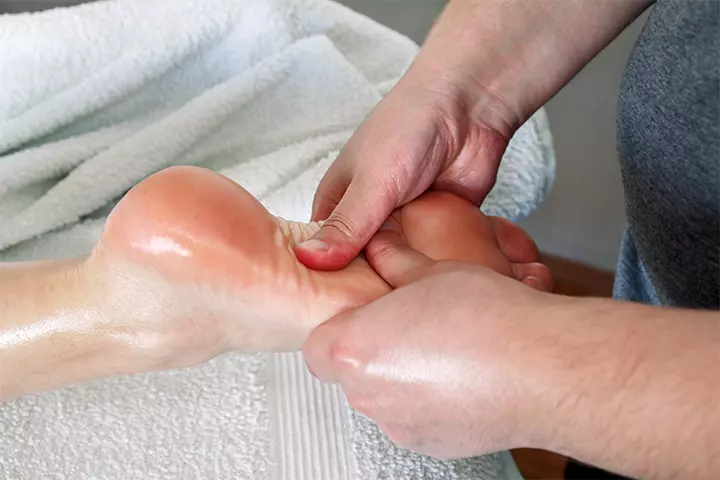
When Should You Avoid Postnatal Massage?
You should avoid a postnatal massage if you have/had:
- Cesarean section; wait until the incision is healed
- Skin conditions such as blisters, boils, eczemaiA skin condition that causes itchy, red, and scaly patches on the skin due to various factors such as allergies, genetics, or stress and rashes
- HerniaiA condition in which an organ protrudes out by pushing into the tissue or muscle surrounding it and high blood pressure
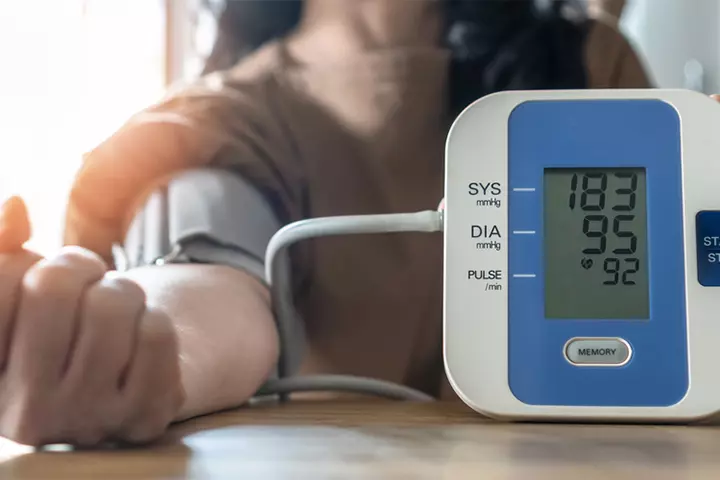
Make sure that you talk to your doctor before getting a massage. This helps you figure out the right kind of massage to get and the right time to get it.
Precautions For Postnatal Massage If You Had C-section
Here are some essential things to remember before getting a postpartum massage:
- Choose a trained massage therapist

Some massage therapists may use oils of specific herbs and fragrances. However, not all may be suitable for you.
Which Oil Is The Best For Postpartum Massage?
Most of the high-grade oils are safe for massages as they are non-allergenic after delivery. You may have to pick the oil that suits you, considering its smell and allergic reactions if any. For that, you may have to try different oils.
Go for a patch test by applying the oil on a small patch of your skin. Check for allergic reactions such as itchiness, redness, or hives. Also check if your baby is comfortable with the smells, as you will be holding the baby and the odor remains even after the bath. If your baby gets fussy because of the smell, try something less pungent or odorless.
Some of the oils you may choose are sweet almond, mustard, coconut, olive, sesame, and herbal oils.
 Quick tip
Quick tipWhy Do They Massage The Uterus After Birth?
Uterine massage is recommended after delivery to reduce postpartum blood loss, and also to reduce the pain associated with uterine muscle contraction (12).
Frequently Asked Questions
1. Is postpartum massage necessary?
No. Getting a postpartum massage is not mandatory, but you may get some sessions to ease your discomfort after childbirth.
2. Can massage damage milk ducts?
No. In fact, postpartum massage can help to open the blocked milk duct, and a good massage can also help to stimulate increased breast milk production (13).
3. How often should I get a fundal massage?
Fundal massage (uterine massage) can be performed immediately after childbirth on mothers to help the uterine muscles contract and prevent postpartum hemorrhageiSevere vaginal bleeding after childbirth causing symptoms such as reduced blood pressure and weakness (14). However, the duration of the massage varies with facilities. It can be performed for 30 seconds and repeated every 10 minutes (a session of five times an hour) with an interval of an hour between sessions (15).
4. How do I do a postpartum massage at home?
You may take the help of your partner or any family member for the postpartum massage. You can also call for a certified massage therapist to attend to you at home or speak to your ob-gyn to learn some self-massage techniques.
Postpartum massage can be done using different techniques like Swedish massage, Jamu massage, and herbal baths. Talk to your massage therapist and decide which technique will suit you the best. Start a postpartum massage session only after you are completely healed from childbirth. You may consult your doctor about it if you have any apprehensions. A regular postpartum massage may relieve pain, promote better sleep, and relax your mind and body. However, since everyone’s body is different, massages may not suit some women. It is better to avoid postpartum massage if you have high blood pressure, hernia, or skin conditions. Also, take proper safety precautions to experience a safe and comfortable postpartum massage.
Infographic: Relaxing Your Mind Post-Delivery
Your body goes through several changes while you are pregnant, both physical and hormonal. After your delivery, the hormonal levels change again, and it might lead to anxiety or postpartum depression. Keeping this infographic handy post-delivery will help you engage in relaxing activities and deal with the stress Illustration: Momjunction Design Team
Illustration: Postpartum Massage: Benefits Techniques And Right Time To Start

Image: Dall·E/MomJunction Design Team
Personal Experience: Source
MomJunction articles include first-hand experiences to provide you with better insights through real-life narratives. Here are the sources of personal accounts referenced in this article.
ⅰ. My Body After Baby | 3 Months Postpartum.https://www.youtube.com/watch?v=iWmOlGHy52U
References
- Aviva Jill Romm; Natural Health After Birth: The Complete Guide to Postpartum Wellness; Pages 50 and 51
- The New Mother – Taking Care of Yourself After Birth; Children’s Hospital of Philadelphia
- Benefits of Massage After Giving Birth; Renaissance College (2017)
- Postpartum Massage; American Pregnancy Association
- Hytten F.; Blood volume changes in normal pregnancy; Clinics in Haemtology
- A. Rothstein; Prenatal & Postpartum Massage: Massage for the Mind, Body & Spirit; Minnesota School of Cosmetology (2018)
- What Is a Swedish Massage; Fremont College
- Choi MS and Lee EJ; [Effects of Foot-Reflexology Massage on Fatigue, Stress and Postpartum Depression in Postpartum Women]; J Korean Acad Nurs (2015)
- Valera Hascup; Cultural Expressions, Meanings, Beliefs, and Practices of Mexican American Women During the Postpartum Period: An Ethnonursing Study; Duquesne University (2011)
- Ridzuan, Mohd H., et al; Traditional and Complementary Medicine Use During Postpartum Period: A Cross-Sectional Analysis at a Rural, Public Maternal and Child Health Clinic in West Malaysia; Cureus (2025)
- Cheng, Hsuesh-Yu, et al; Effect of Acupressure on Postpartum Low Back Pain, Salivary Cortisol, Physical Limitations, and Depression: A Randomized Controlled Pilot Study; Journal of Traditional Chinese (2025)
- Hofmeyr GJ et al.; Uterine massage for preventing postpartum haemorrhage; Cochrane Database Syst Rev (2008)
- Umesh Patel, et al.; Effect of back Massage on Lactation among Postnatal Mothers; International Journal of Medical Research and Review (2013)
- Childbirth Diaries: Fundal Massage; Penn Medicine Lancaster General Health.
- SabahLotfy Mohamed El Sayed; Effect of uterine massage and emptying of the urinary bladder on alleviation of afterpains among mothers in the immediate postpartum period; International Journal of Africa Nursing Sciences (2025)
Community Experiences
Join the conversation and become a part of our nurturing community! Share your stories, experiences, and insights to connect with fellow parents.
Read full bio of Dr. Prachi Benara
Read full bio of Rebecca Malachi
Read full bio of Dr. Ritika Shah
Read full bio of Reshmi Das







